
There are four main types of Cerebral Palsy and Spastic is the most common, making up for at least 70% of all CP diagnoses. This type is mainly characterized by muscle stiffness, tightness, and poor coordination. However, Spastic Cerebral Palsy is also broken down into types and there are three of them. Here is more information on the three types of Spastic Cerebral Palsy.
Spastic Quadriplegia
This type of Spastic Cerebral Palsy is specific to movements in the arms and the legs. Children diagnosed with Spastic Quadriplegia mainly have difficulty controlling their arm and leg movements. However, instead of muscle paralysis, they will experience muscle jerking due to the stiffness. Spastic Quadriplegia is typically caused by damage to a specific part of the nervous system, brain damage, a brain bleed, or lack of oxygen to the brain. Though it is characterized by arm and leg movements, this type normally affects the entire body, including facial muscles and our core.
Spastic Diplegia
Spastic Diplegia focuses on the lower part of the body, primarily the legs. Also known as Little’s Disease (named after the doctor who first wrote about it), Spastic Diplegia is less severe than Spastic Quadriplegia because it only impacts the legs. Children typically show signs within the first few years of their lives and will have scissoring or contracting movements of their leg muscles. Though the legs are the main body part affected, children with this type of Spastic Cerebral Palsy may also have some developmental conditions arise such as vision problems.
Spastic Hemiplegia
Opposite of Spastic Diplegia, this type of Spastic Cerebral Palsy mainly affects the upper body rather than the lower body. This form is a little bit different than the others because it impairs the brain’s ability to send the proper nerve signals to a patient’s muscles. Symptoms of this type will also show up in the first few years of a child’s life and includes involuntary muscle movements of the upper body. This is the most common form of Spastic Cerebral Palsy.
Has Your Child Been Diagnosed with Cerebral Palsy? Contact The Snyder Law Group Today
The Snyder Law Group, LLC, proudly represents clients throughout Maryland and Washington, D.C. Our experienced Baltimore attorneys understand the frustration that comes with an insurance company, medical professional, or other party that refuses to accept liability for negligent or reckless behavior. You can take heart in knowing there are talented and experienced lawyers ready to work for you. We are experienced in handling personal injury claims of medical malpractice or injury resulting from serious car and truck accidents, and have secured hundreds of millions in verdicts settlements*. Please visit our website, www.410thefirm.com, for more information and follow us on Facebook, Twitter , and LinkedIn.
